How does Gen Z see its place in the working world? With trepidation
October 22, 2022

Americans 18 to 24 years old report high rates of mental-health challenges, impediments to effective work, and worries about the future.
Youth can be an exhilarating time but also one of high anxiety, as young people struggle to establish themselves economically and find their place in society. While each generation may encounter struggles and doubts as they join the workforce, Generation Z 1 has entered the working world during a global pandemic and amid concerns over rising inflation rates, recession fears, geopolitical conflicts, and climate change. The latest iteration of McKinsey’s American Opportunity Survey (AOS) reveals a generational gap in the workplace, with marked differences among how Gen Z and other generations view themselves, their ability to work effectively, and their futures.
Our spring survey of 25,062 Americans included 1,763 respondents (see sidebar, “Our methodology”) in the Gen Z age range of 18 to 24. Our survey shows that Gen Z respondents who are working are more likely to have independent jobs or multiple jobs than older workers. Unlike other generations, they are less likely to expect this period of financial insecurity to end and have high levels of doubts about their eventual ability to either buy homes or retire.
Employed Gen Z respondents are more likely to report that the pay they receive for their work does not allow them a good quality of life (26 percent, compared with 20 percent of other respondents) and are less likely than others to report feeling fairly recognized and rewarded for their work (56 percent, compared with 58 percent of other respondents). A remarkable 77 percent of Gen Z respondents report looking for a new job (almost double the rate of other respondents). While some degree of job churn in early careers is expected, the economic pessimism reported by Gen Z—only 37 percent believe that most people in this country have economic opportunities—suggests a deep malaise about their own prospects and those of other Americans.
Some of the differences in how the generations respond to survey questions suggest concerning levels of distress among young people, including an astounding 55 percent reporting having either been diagnosed with or having received treatment for mental illness (compared with 31 percent of people aged 55 to 64 reporting the same). US Surgeon General Vivek Murthy issued a public health advisory in December 2021 to address the “youth mental-health crisis” exacerbated by the COVID-19 pandemic. 2 Our research underscored the urgency of these problems.
Some other differences between age groups are also notable. Young people report physical-health issues as an impediment to effectively performing work at higher rates than the general population, which includes people decades older than them. In fact, on every metric that interferes with effectively performing work, Gen Z reports more struggles than the general population.
The AOS gives us a window into the mindset of the newest generation to enter the job market. Employers and other stakeholders may want to reflect upon this research and use it to gain a deeper understanding of how Gen Z feels about itself and its place in the working world, and how they can best support this cohort in the workforce.
Gen Z’s employment patterns are less stable—and that worries them
Slightly more than half of the 18- to 24-year-olds surveyed are employed, but they have different experiences than workers of other ages. To start, they are more likely to be working multiple jobs (a quarter, compared with 16 percent of all workers) and are more likely to be doing independent work (slightly more than half, compared with 36 percent). While a portion of young people do independent work because they enjoy the work (28 percent) or because of the autonomy and flexibility it offers (24 percent), a majority would prefer work as a permanent or noncontract employee (56 percent
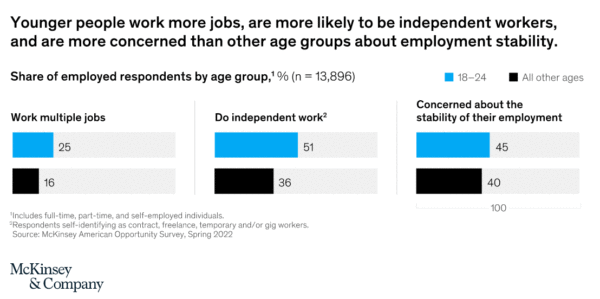
Gen Z is less financially secure: 45 percent are concerned about the stability of their employment (compared with 40 percent of all respondents) and are less likely than other respondents to report being able to cover living expenses for more than two months if faced with job loss. Gen Z is also more likely to report that the pay they receive does not allow for a good quality of life.
Some of these trends may be by virtue of age and experience in the workforce; young people early in their careers typically earn less than those with more experience. Young workers are also less likely to have partners and dependents to support, so they may have the flexibility to work multiple jobs or work in independent positions that those with families may avoid.
Many young people doubt they will ever hit key economic milestones
Almost a quarter of Gen Z respondents do not expect to retire, and only 41 percent expect to own a home one day.
Optimistic explanations for these generational differences could be that young people enjoy their work and simply don’t want to retire, prefer to invest their capital in assets other than homes, or expect more geographic mobility than previous generations and want to maintain that flexibility without having a mortgage. It is also possible that people so far from both the typical age for retirement and home buying simply cannot envision themselves reaching these life phases. Another explanation may be that everyone feels this way in their youth, and had we surveyed previous generations when they were in the 18 to 24 age range, we may have seen similar results. It will be the work of our future research to parse which sentiments are most likely explained by respondents being in a particular life stage (such as being 18 to 24 years old) and which are unique to Gen Z when compared with other generations.
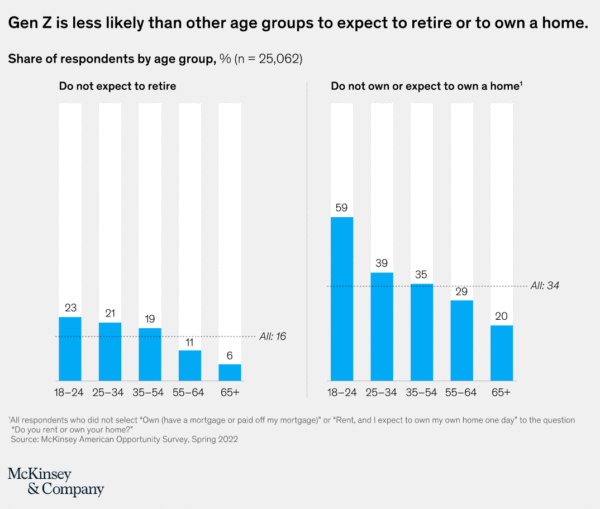
A more pessimistic interpretation may be that young people expect their current job instability and financial insecurity to continue as their lives progress. National statistics support the notion that home buying and retirement are increasingly distant goals: the median age of an American home buyer was 56 last year, up from 36 in 1981. 1 Student debt represents a barrier to home buying for many young people. 2 Most Americans—even those approaching retirement age—lack sufficient savings to retire. 3 Gen Z’s fear of never reaching traditional economic milestones may reflect greater pessimism and hopelessness than other generations have experienced.
Gen Z finds it harder to work well for physical, mental, and practical reasons
We asked respondents whether various factors had an impact on their ability to effectively perform their work. There are five factors that employed 18- to 24-year-old respondents are more or as likely to cite as having a major impact compared with respondents of every other age group: a hostile work environment, mental-health issues, access to transportation to and from work, physical issues, and an inability to share your full self at work. Some of these factors may have a compounding effect; we’ve previously reported on the ties between toxic workplace behavior, inclusivity, mental health, and attrition.
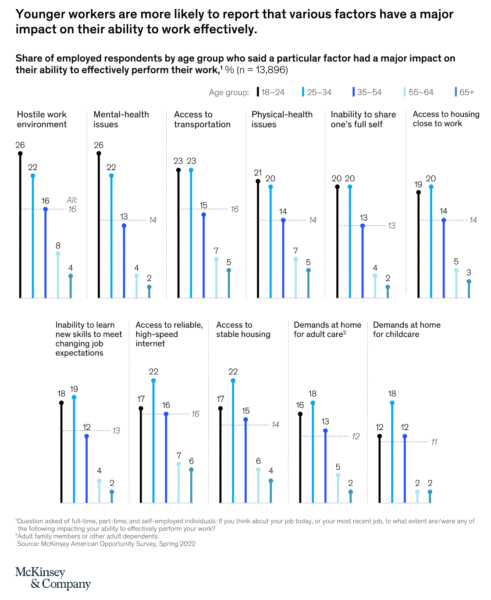
Over a quarter of 18- to 24-year-olds say mental-health issues have a major impact on their ability to perform at work (compared with 14 percent of all employed respondents). A third of 18- to 24-year-olds report believing that their mental health has a negative impact on their future job prospects. This belief appears to decline with age: the proportion of respondents reporting this dropped by five to six percentage points for every ten years gained.
A puzzling finding was that of all employed workers, the youngest cohort is the most likely to report physical-health issues having a major impact. One explanation could be that older workers who experience physical-health issues are more likely to not be working as a result (32 percent of unemployed 55- to 64-year-olds say that physical health is a cause of their unemployment, compared with 9 percent of unemployed 18- to 24-year-olds).
Gen Z reports remarkably high rates of mental-health struggles
One of the most notable findings of the survey is that 55 percent of 18- to 24-year-olds report having received a diagnosis and/or treatment for a mental illness. Respondents aged 55 to 64 years old, with decades more time to have received a diagnosis or gone into treatment, report this is the case 31 percent of the time. There are large variations across race and ethnicity in each age category: Asian Americans aged 35 to 54 years old report rates of diagnosis and/or treatment at less than half the rate of their White counterparts.
The results of this survey echo McKinsey’s previous research on the impact of the COVID-19 pandemic on mental well-being. In addition to Gen Z respondents reporting a less positive life outlook than older generations in that study, Gen Z respondents were also more than three times as likely as other generations to report seeking treatment for thinking about or planning suicide in the 12-month period spanning late 2019 to late 2020 (7 percent, compared with 2 percent of those aged 41 to 56, and less than 2 percent for all other respondents).
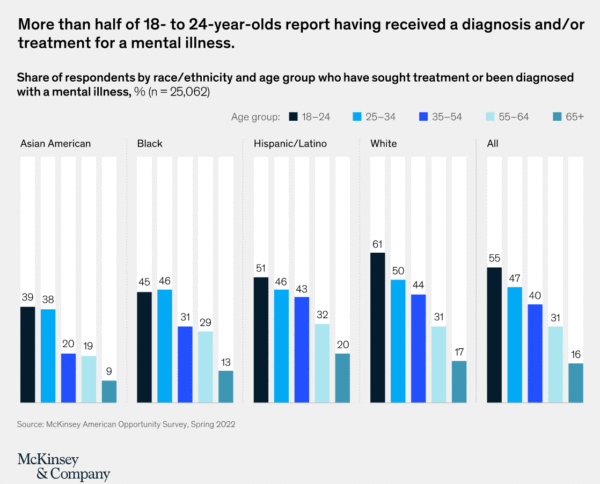
The higher percentage of young people reporting mental-health challenges may be due to increased awareness of mental health, a greater willingness to seek help, or an environment ripe for creating or aggravating mental-health issues. US Surgeon General Vivek Murthy’s public advisory noted that while mental-health concerns among youth have been rising in recent years, the pandemic accelerated the problem: “The pandemic added to the pre-existing challenges that America’s youth faced. It disrupted the lives of children and adolescents, such as in-person schooling, in-person social opportunities with peers and mentors, access to health care and social services, food, housing, and the health of their caregivers.”
Gen Z bears specific burdens due to their life stage, including emotional stress and grief from the pandemic and educational challenges from remote or interrupted learning. Those looking for jobs in the past few years have experienced something of a rollercoaster: youth unemployment reached an all-time high of 27.4 percent in April 2020 and has since settled to 8 percent in August 2022. 2 Even young people with the benefit of being college graduates have encountered difficulties finding jobs, 3 had their previously secured job offers rescinded, 4 or were unable to apply to graduate school because of the timing of the lockdowns throughout the pandemic.
Gen Z wants mental healthcare but worries about paying for it
Gen Z is more likely to report receiving treatment or diagnosis for a mental-health condition but also the most likely to report being unable to afford mental-health services (a fifth, compared with 14 percent of all respondents). Respondents aged 18 to 24 are 3.4 times more likely to cite a lack of access to affordable mental-health services as a top-three barrier to their well-being compared with 55- to 64-year-olds.
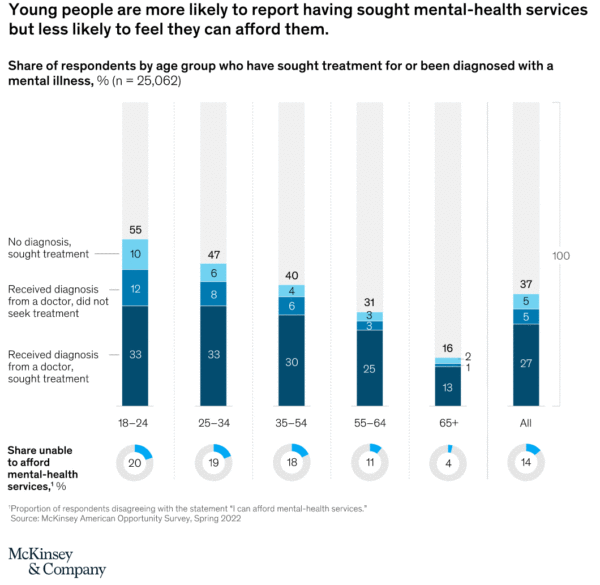
Twelve percent of 18- to 24-year-olds report receiving a diagnosis but not treatment, much higher than the 5 percent reported for all respondents. Stigma associated with mental and substance-use disorders and a lack of family support may be a barrier to accessing mental- health care. Twenty-seven percent of 18- to 24-year-olds rely on their parent’s or school’s insurance; reluctance to communicate with elders about mental-health topics may be a deterrent.
In spite of its worries, Gen Z thinks the economic future is brighter than most other age groups do
Despite reporting higher levels of job insecurity and financial instability and higher rates of emotional distress and obstacles to working effectively, Gen Z’s view of economic opportunity is more optimistic than that of Gen X and baby boomers.
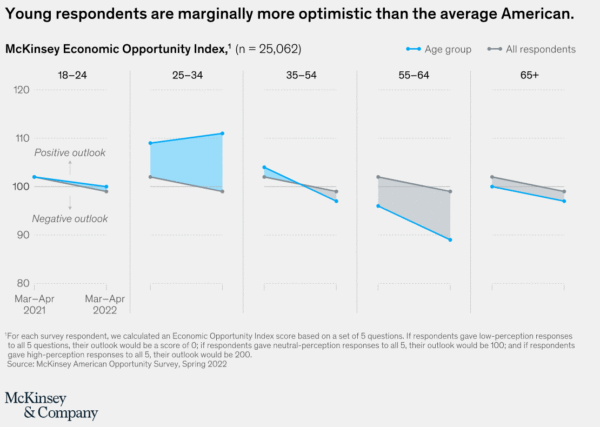
The McKinsey Economic Opportunity Index—a scale that gauges Americans’ perceptions of past, present, and future economic opportunity—shows that Gen Z scored 100.4 (where 100 represents a neutral outlook), which is higher than every age cohort except for the one immediately above it. Not only that, Gen Z’s optimism decreased by only 1.6 percent over the last year, compared with 3 percent for all respondents on average.
The only respondents who clearly feel far more positive than Gen Z are the ones aged 25 to 34. These slightly older young people, who have typically launched into their careers and have had more time to find their place in society, report the brightest outlook of all generations.
Young respondents are marginally more optimistic than the average American.
Worrying about the mindset of the young has been popular at least since the times of Aristotle and Socrates and likely long before that. Some of Gen Z’s reported distress will sound familiar to all who have lived through the apprehension and doubt of launching themselves into economic independence.
However, the high rates of reported mental-health challenges and other major obstacles to effective work that emerged from this research invite reflection. Gen Z respondents report alarming levels of negativity about themselves, their confidence in the future, and their ability to find contentment in American life.
Gen Z respondents report alarming levels of negativity about themselves, their confidence in the future, and their ability to find contentment in American life.
While Gen Z is not the only generation facing mental-health challenges, their rates of distress may give employers, educators, and public-health leaders pause. These stakeholders may want to consider the sentiment of this emerging generation as they plan for the future. Employers who want to win their fair share of talent from all age groups in the workforce can use these insights to target their support for this critical group.
About the author(s)
André Dua is a senior partner in McKinsey’s Miami office; Kweilin Ellingrud is a senior partner in the Minneapolis office; Michael Lazar is a partner in the New York office, where Ryan Luby is an associate partner; and Sarah Pemberton is a manager in the Hong Kong office.































